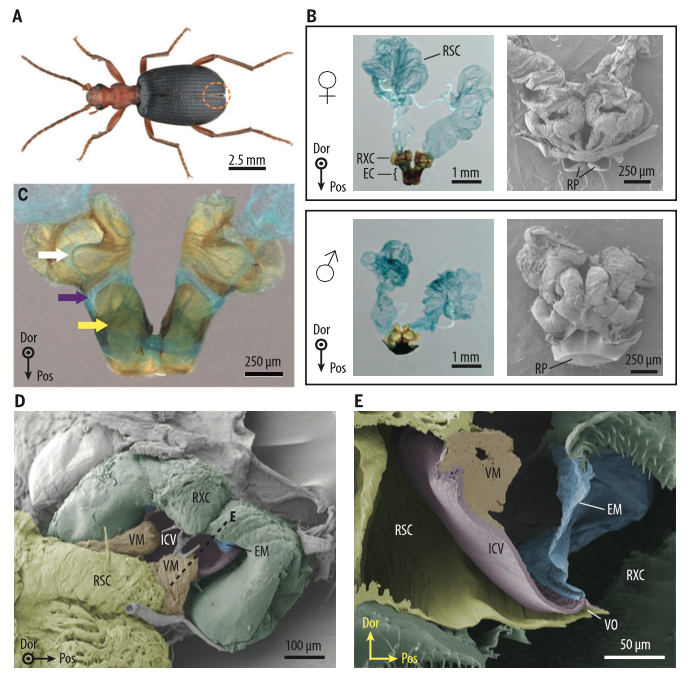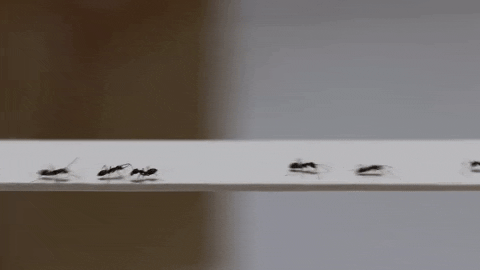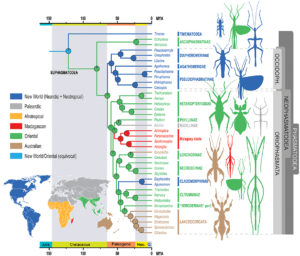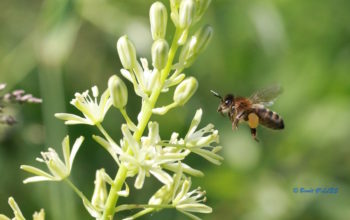Threatened, the bombardier beetles spray from their abdomen an irritating defensive liquid by a succession of very fast jets. This phenomenon begins in the pygidial glands, where two reagents mix, causing an explosion under high pressure and the release of this liquid. The internal and anatomical mechanisms enabling this prowess have just been described by the American team of Eric M. Arndt of the Massachusetts Institute of Technology (MIT). Jet control is achieved through an autonomous passive feedback mechanism that does not require a nerve or muscle pathway.
Bomber beetles belong to the family Carabidae and Barchinini tribe (figure 1A). These insects have the faculty to expel a defensive liquid under pressure by successive jets in order to spray some on what threatens them, a predator for example (see video at the end of article). This defensive liquid, derived from the pygidial glands, is composed of a mixture of several molecules including the p-benzoquinones : an irritant compound used by all arthropods.
However, bombers are the only insects that use an explosive internal chemical reaction to expel this molecule. The reaction also induces heat.
The liquid spray is particularly impressive : a temperature close to 100°C, ranges of several centimeters, a speed around 10m per second!
In the species Stenaptinus insignis, the frequency of emission of the jets is between 368Hz and 735Hz, thus giving the impression of a single spray (frequency close to the flapping of the wings of an insect in flight : lire cet article).
Anatomical description of the defensive system
Pygidial glands are composed of three elements : 1) the reservoir chamber (RSC), 2) the reaction chamber (RXC), 3) an outlet channel (EC) giving on the end of the abdomen ( see figure 1B).
caption id=”attachment_2069″ align=”alignright” width=”391″] Figure 1 : Morphology of the pygidial glands of Brachinus elegantulus – A) Back view, B) Pygidial glands : female (top) and male (bottom), C) Sclerotization variation : strongly (brown) and slightly (blue), D) Inter-chamber valve (VM : valve muscle), E) Inter-chamber valve (VO : valve opening) (Source : Arndt et al., 2015)[/caption]
Figure 1 : Morphology of the pygidial glands of Brachinus elegantulus – A) Back view, B) Pygidial glands : female (top) and male (bottom), C) Sclerotization variation : strongly (brown) and slightly (blue), D) Inter-chamber valve (VM : valve muscle), E) Inter-chamber valve (VO : valve opening) (Source : Arndt et al., 2015)[/caption]
At the end of the output channel are reflective plates (RP) whose role is to orient the direction of the jet ( see figure 1B). The two chambers are separated, as well as their respective reagents, by an inter-chamber valve (ICV) (see figure 1D and E).
Pygidial glands are made of chitin (part of the cuticle, to know more lire this article) protecting the internal organs of the insect from toxic chemical molecules, high temperatures and high pressures.
The tank chamber contains an aqueous solution composed of 25% hydrogen peroxide, 10% p-hydroquinones and 10% alkanes (non-reactive). When the inter-chamber valve opens, the reagents in the tank chamber come into contact with those in the reaction chamber, enzymes (peroxidase and alkalase), resulting in the formation of p-benzoquinones, oxygen gas, water vapour and heat.
Defensive spray sequence
Eric M. Arndt and his colleagues were able, thanks to optical microscopy and electronic digitization, to describe precisely the internal structures and the different stages of the process.
Optical microscopy revealed heterogeneous cuticular sclerotization of the reaction chamber. Some regions are thus more flexible or rigid than others. In figure 1C, the slightly sclerosed and flexible areas are in blue, the strongly sclerosed and rigid areas in brown.
Every drop of reagent emitted from the tank chamber into the reaction chamber (opening of the inter-chamber valve) causes an explosion lasting 0.1ms which generates a pressure of 20kPa in the reaction chamber and a tensile force on the walls of 1MPa (for comparison, car tyres are generally inflated to 2.2Pa).
Jet control is performed at the inter-chamber valve by an open/close phenomenon. Contrary to other cyclic mechanisms such as that of the comings and goings of the wings during the flight of the insect (alternative contractions of whole muscles lire this article on the flight of insects), only the opening implies the muscular action, the closing is passive : mechanical feedback.
caption id=”attachment_2073″ align=”alignright” width=”394″] Figure 2 : Spray mechanism – A) Inactive gland, B) Reagent entry into reaction chamber (RXC), C) Inter-chamber valve explosion and closure, D) End of explosion, opening of inter-chamber valve and new reagent entry for new cycle, E) End of spray, outlet channel closed, residues of explosion remain in reaction chamber (Source/span> : Arndt et al., 2015)[/caption]
Figure 2 : Spray mechanism – A) Inactive gland, B) Reagent entry into reaction chamber (RXC), C) Inter-chamber valve explosion and closure, D) End of explosion, opening of inter-chamber valve and new reagent entry for new cycle, E) End of spray, outlet channel closed, residues of explosion remain in reaction chamber (Source/span> : Arndt et al., 2015)[/caption]
The pressure released by the explosion closes the inter-chamber valve, interrupting the supply of reagent from the tank chamber. The release of the reagent and the decrease of the pressure allow the opening and the arrival of a new drop of reagent, starting a new cycle ( see figure 2).
The spray will last as long as the tank chamber contains reagent, or as long as the insect keeps the inter-chamber valve open (stress period).
The bomber’s internal mechanisms and anatomy are remarkably effective. The control of the jets is done in a passive way, without muscular action, by a process of feedback. This system allows an automatic regulation of the jets and the use of the reagent.
Other species close to Barchinini also emit sprays during a threat, but continuously. The evolutionary changes at the origin of the appearance of a jerky spray, which occurred in the bombers’ ancestors, are minor and the structural modifications above all: at the level of the inter-chamber valve, they do not imply any particular anatomical and muscular adaptation.
This work was done with a view to designing new technologies such as explosion mitigation and propulsion.
Video of a defensive spray of a bomber beetle :
Source :
– Arndt E.M. ; Moore W. ; Lee W.K. & Ortiz C. (2015) : Mechanistic origins of bombardier beetle (Brachinini) explosion-induced defensive spray pulsation. Science, vol348(6234):563-567 (link)





